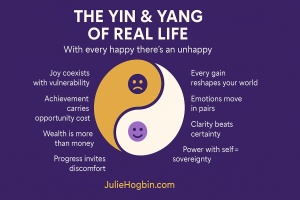With Every Happy There’s an Unhappy: The Yin & Yang of Real Life
We all chase the happy. Promotions, milestones, new relationships, a full bank account, and sadly, some think they can never be happy, because they feel they need more. Chasing is not the answer, and that is another article
Yet life has a way of reminding us: every “happy” arrives with an “unhappy.” That’s not bad news—it’s balance. It’s the Yin & Yang (often misspelled “ying and yan”) of being human: light and shadow, rise and rest, joy and grief existing together.
When we understand this polarity, we stop fighting half of our experience. We lead better, love deeper, and make decisions that hold both the upsides and the trade-offs. That’s conscious leadership in action.
What this really means (and why it matters)
Every gain reshapes your world. The dream role can bring status and stress. New income expands freedom and responsibility.
Emotions move in pairs. Joy doesn’t delete sorrow; it sits beside it. The goal isn’t to “stay positive”—it’s to stay whole.
Clarity beats certainty. When we look honestly at both sides, we make choices we can live with—without self-betrayal.
If you’ve ever felt pressured to “just be positive,” you’ll know the cost of ignoring the other side. For a deeper dive into the risks of one-sided thinking, see Julie’s piece on toxic positivity and the importance of emotional honesty (and boundaries) in real life leadership.
👉 Explore related articles: Articles hub
The Yin & Yang of emotion in practice
1) Joy coexists with vulnerability
The more we love, the more we risk loss. That doesn’t mean love less; it means love consciously—with boundaries, presence and self-respect.
2) Achievement carries opportunity cost
Saying yes to one horizon means saying no to others. Great leaders name these trade-offs upfront so teams don’t pay “hidden taxes” later. For tools that help you see capability and motivation clearly, try Julie’s Can-Do/Will-Do Matrix.
👉 Can-Do Will-Do Matrix
3) Wealth is more than money
Financial growth is wonderful and incomplete without health, relationships and purpose. That fuller picture is what Julie calls true wealth.
👉 Book: Wealth Beyond Money
4) Progress invites discomfort
Change rewires habits and identity. The trick isn’t to avoid discomfort—it’s to use it intelligently. See Julie’s guide to mental flexibility and change.
👉 Unleash Your Mental Plasticity
5) Power with self = sovereignty
Holding both sides builds sovereignty—your ability to choose in alignment with values, not pressure.
👉 I Am Sovereign—what it really means
How to balance the polarity (without losing your centre)
Name both sides, aloud. When deciding, write “Upsides” and “Downsides” in equal columns. If you can’t name three honest downsides, you’re not ready to choose.
Measure reality, not mood. Use simple weekly metrics (energy, focus, finances, relationships) to avoid emotionally-led whiplash.
Set “healthy cost” limits. Decide what you won’t trade (sleep, integrity, connection). Guard these non-negotiables.
Practise “Both/And” language. Replace “but” with “and.” Example: “This is exciting and it creates new risks; here’s how we’ll hold both.”
De-risk perfectionism. Excellence is brilliant until it blocks movement. If you struggle to hit publish or delegate, read this next:
👉 Perfectionism Trap—5 Practical TipsAudit your biases. Our brains tilt toward one-sided stories. If you’re making high-stakes choices, sanity-check them against common cognitive traps.
👉 13 Cognitive Biases that Undermine LeadershipRe-anchor to your “Why.” When trade-offs bite, surface your deeper reason so you don’t quit for the wrong reason.
👉 7 Levels Deep: Asking “Why?” for clarity
Leadership, decisions and “productive tension”
High-quality leadership isn’t the absence of tension—it’s the productive holding of it. In practice:
State the upside clearly. What value are we creating? For whom?
State the cost clearly. What does this demand in time, focus, cash, and reputation risk?
Plan the buffer. What restores us when the “unhappy” arrives (because it will)?
Communicate rhythm. Teams perform best when they know when to sprint and when to recover.
Want a structured path to these skills? Explore The Leadership Voice programme.
👉 The Leadership Voice
Wealth: finding balance beyond the bank balance
Money expands choices and reveals values.
Investments create freedom and require patience and resilience.
Scaling income is empowering and demands boundaries to protect your health and relationships.
If you’re building wealth, build whole-life wealth—on purpose.
👉 True Wealth Thinking
👉 Wealth Beyond Money (book)
When the “unhappy” shows up—do this
Pause; name the feeling. “I feel anxious/grief/anger.”
Locate the lesson. “What is this asking me to strengthen or release?”
Right-size the response. Not every feeling warrants a pivot. Some want rest, boundaries, or a better plan.
Renew your “why,” then act. Action beats rumination—especially tiny, repeatable steps.
For ongoing support and practical conversations on leading a whole life, tune into Julie’s Success Suite Podcast.
👉 Listen to the podcast
Key takeaways
The goal isn’t unbroken happiness; it’s honest wholeness.
Great decisions respect both sides: upside and cost.
True wealth integrates money, health, relationships and purpose.
Conscious leaders name the shadow, plan for it, and keep moving.

